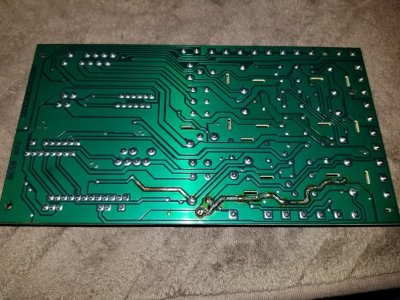JunkyardDog
Member
3 years after having another Distribution Block issue (https://www.expeditionforum.com/threads/power-distribution-relay-issue.26809/), I have a new issue. In late September, my daughter was using this vehicle at college (her car broke down and she borrowed this vehicle while I had her car, so I could work on it). She made a stop and when she returned it would not start. When in the RUN position, everything appeared normal. Twisting the ignition to start it and there was no crank at all. After 3 trips (@ 150 miles each), a funeral (longer story - a real funeral), and a 150 mile tow, I managed to get the right information to find a way to jumper the relay that was not working (I knew it would start if I could connect the right points). Due to everything else that has raining on my parade, I just now managed to get a look at it. I have been using my jumper to drive it everywhere. Otherwise, it runs fine and starts right up.
Since I had already pulled the distribution block out before, I knew I could fix it, if I could see the issue.
Well, I got it apart and all I find is another stressed trace. However, it is not open and it is not part of the starting circuit. I beefed up the trace like I did the other trace last time (The picture is the before beefing look.).
It is my understand of the following:
The relay in question (C2163 – Starter Relay) receives positive DC voltage from the ignition key (when turned to the START position), through the Neutral Safety Switch, via Pin 86, which is one side of the relay coil. Pin 85, the other side of the relay coil, is pulled low, via the computer, when all conditions to start are met (Alarm is disabled, etc.) When both of these conditions are met, the relay coil is energized; connecting Pin 30 to Pin 87. Pin 30 is connected to the Main Power Buss, and the Battery, power through Fuse 101 (30A). Pin 87 is connected to a 7/8 connector (I don't have any designations for these connectors. It happens to be the only connector that has 7 pins inserted for eight possible pin locationss.), on the back of the distribution panel.
Since I have been able to literally jumper the Pin 30 to Pin 87 manually to get it to start, those connections should be good. I do see 12 volts at Pin 86. Testing it with a test light, it can supply the low current to enable the relay.
My suspicion is that Pin 85 is not being pulled low enough, or at all. Whether it is the PCM or the wiring, I don't know yet. Right now, I am building a basic low power test light. I think a regular test light might draw too much current. Can anybody provide any insight to how I can BETTER test the PCM?

Since I had already pulled the distribution block out before, I knew I could fix it, if I could see the issue.
Well, I got it apart and all I find is another stressed trace. However, it is not open and it is not part of the starting circuit. I beefed up the trace like I did the other trace last time (The picture is the before beefing look.).
It is my understand of the following:
The relay in question (C2163 – Starter Relay) receives positive DC voltage from the ignition key (when turned to the START position), through the Neutral Safety Switch, via Pin 86, which is one side of the relay coil. Pin 85, the other side of the relay coil, is pulled low, via the computer, when all conditions to start are met (Alarm is disabled, etc.) When both of these conditions are met, the relay coil is energized; connecting Pin 30 to Pin 87. Pin 30 is connected to the Main Power Buss, and the Battery, power through Fuse 101 (30A). Pin 87 is connected to a 7/8 connector (I don't have any designations for these connectors. It happens to be the only connector that has 7 pins inserted for eight possible pin locationss.), on the back of the distribution panel.
Since I have been able to literally jumper the Pin 30 to Pin 87 manually to get it to start, those connections should be good. I do see 12 volts at Pin 86. Testing it with a test light, it can supply the low current to enable the relay.
My suspicion is that Pin 85 is not being pulled low enough, or at all. Whether it is the PCM or the wiring, I don't know yet. Right now, I am building a basic low power test light. I think a regular test light might draw too much current. Can anybody provide any insight to how I can BETTER test the PCM?


